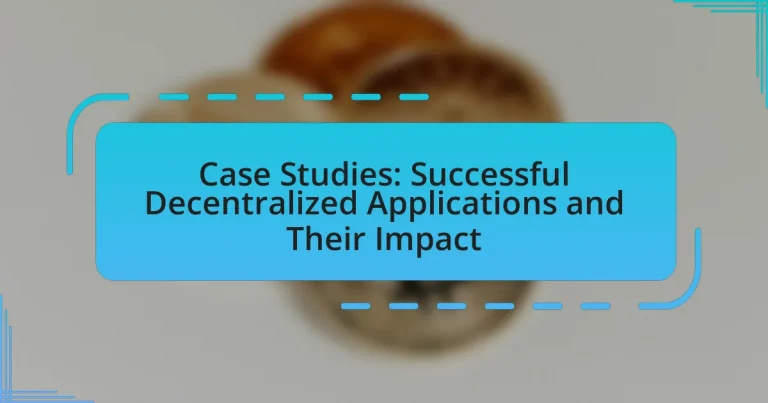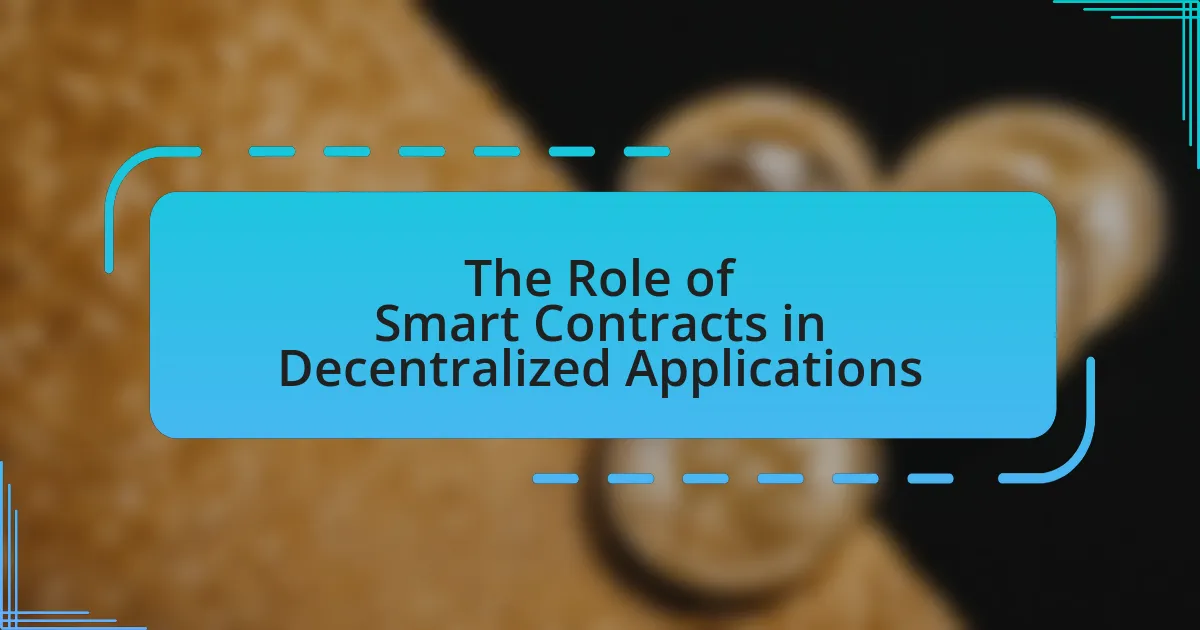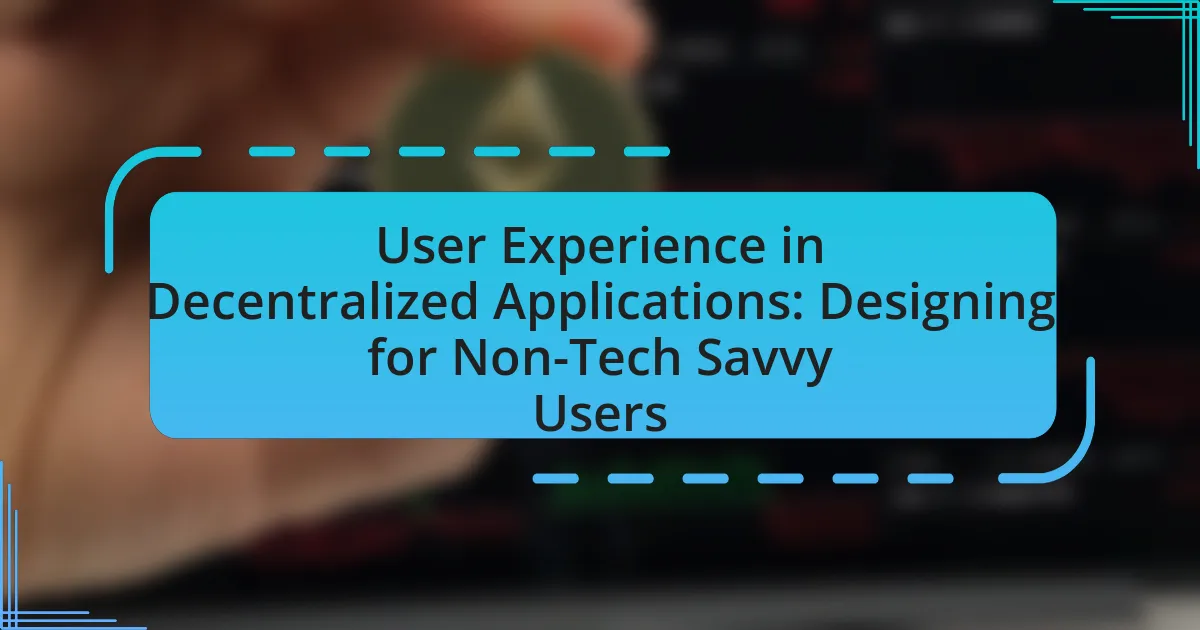Decentralized Applications (dApps) are software applications that operate on blockchain or peer-to-peer networks, utilizing smart contracts to enhance security, transparency, and user control. This article explores the characteristics, technologies, and advantages of dApps, highlighting their differences from traditional applications. It examines successful case studies, such as Ethereum and Uniswap, which have transformed various industries by enabling decentralized finance and peer-to-peer trading. Additionally, the article addresses the challenges dApps face, including scalability and regulatory compliance, while discussing future trends and best practices for developers in the evolving landscape of decentralized technology.
What are Decentralized Applications (dApps)?
Decentralized Applications (dApps) are software applications that run on a blockchain or peer-to-peer network, rather than being hosted on centralized servers. dApps utilize smart contracts to facilitate and automate processes without the need for intermediaries, ensuring transparency and security. For example, Ethereum is a widely used platform for developing dApps, which allows developers to create applications that are resistant to censorship and fraud. The decentralized nature of dApps enhances user control over data and reduces reliance on single entities, making them a significant innovation in the digital landscape.
How do decentralized applications differ from traditional applications?
Decentralized applications (dApps) differ from traditional applications primarily in their architecture and control mechanisms. While traditional applications typically operate on centralized servers controlled by a single entity, dApps run on decentralized networks, such as blockchain, which distribute control among multiple participants. This decentralization enhances security and reduces the risk of single points of failure, as evidenced by the resilience of blockchain networks like Ethereum, which has maintained uptime and integrity despite various attacks. Additionally, dApps often utilize smart contracts to automate processes without intermediaries, contrasting with traditional applications that rely on centralized databases and manual oversight.
What technologies underpin decentralized applications?
Decentralized applications (dApps) are primarily underpinned by blockchain technology, smart contracts, and peer-to-peer networking. Blockchain serves as the foundational ledger that ensures transparency and immutability of data, while smart contracts automate processes and enforce agreements without intermediaries. Peer-to-peer networking facilitates direct interactions between users, enhancing security and reducing reliance on centralized servers. These technologies collectively enable the creation and operation of dApps across various platforms, such as Ethereum and Binance Smart Chain, which have been instrumental in the rise of decentralized finance (DeFi) and non-fungible tokens (NFTs).
What are the key characteristics of decentralized applications?
Decentralized applications (dApps) are characterized by their reliance on blockchain technology, which ensures transparency, security, and immutability. These applications operate on a peer-to-peer network rather than a centralized server, allowing users to interact directly without intermediaries. Additionally, dApps are open-source, meaning their code is publicly accessible, promoting community collaboration and trust. They often utilize smart contracts to automate processes and enforce agreements without human intervention. The decentralized nature of dApps enhances user privacy and control over personal data, as users retain ownership of their information. These characteristics collectively contribute to the resilience and innovation seen in successful dApps, as evidenced by platforms like Ethereum, which supports a wide range of decentralized applications.
Why are decentralized applications gaining popularity?
Decentralized applications are gaining popularity due to their ability to provide enhanced security, transparency, and user control. These applications operate on blockchain technology, which eliminates the need for intermediaries, thereby reducing the risk of data breaches and fraud. According to a report by Gartner, the adoption of blockchain technology is expected to grow significantly, with 70% of organizations planning to invest in decentralized solutions by 2025. This trend reflects a growing demand for systems that empower users and ensure data integrity, making decentralized applications increasingly attractive in various sectors.
What advantages do decentralized applications offer to users?
Decentralized applications (dApps) offer users enhanced security, privacy, and control over their data. Unlike traditional applications that rely on centralized servers, dApps operate on blockchain technology, which ensures that user data is encrypted and distributed across a network, reducing the risk of data breaches. For instance, a study by the World Economic Forum highlights that blockchain’s decentralized nature can significantly lower the chances of hacking, as there is no single point of failure. Additionally, dApps empower users by allowing them to interact directly with the application without intermediaries, fostering greater transparency and trust in transactions. This model not only protects user identities but also enables users to retain ownership of their data, aligning with the growing demand for privacy in the digital age.
How do decentralized applications enhance security and privacy?
Decentralized applications enhance security and privacy by utilizing blockchain technology, which ensures data integrity and user anonymity. By distributing data across a network of nodes rather than storing it in a central location, decentralized applications reduce the risk of data breaches and unauthorized access. For instance, in a study by the University of Cambridge, researchers found that blockchain’s cryptographic techniques significantly lower the chances of data tampering, thereby reinforcing security. Additionally, decentralized applications often allow users to control their own data, minimizing reliance on third-party entities that could compromise privacy. This user-centric approach is supported by the fact that decentralized identity solutions, such as those implemented in projects like uPort, empower individuals to manage their personal information securely.
What are some successful case studies of decentralized applications?
Successful case studies of decentralized applications include Ethereum, which enabled the creation of smart contracts and decentralized finance (DeFi) platforms, revolutionizing financial transactions and services. Another notable example is Filecoin, a decentralized storage network that incentivizes users to rent out their unused storage space, addressing data storage challenges. Additionally, Uniswap, a decentralized exchange, allows users to trade cryptocurrencies directly without intermediaries, showcasing the potential for peer-to-peer trading. These applications demonstrate the transformative impact of decentralization on various industries, evidenced by Ethereum’s market capitalization exceeding $200 billion and Uniswap facilitating billions in trading volume.
How have specific decentralized applications transformed industries?
Specific decentralized applications have transformed industries by enabling greater transparency, efficiency, and security in transactions. For instance, Ethereum has revolutionized the finance sector through smart contracts, which automate and enforce agreements without intermediaries, reducing costs and increasing trust. In supply chain management, applications like VeChain provide real-time tracking of goods, enhancing accountability and reducing fraud. Additionally, decentralized finance (DeFi) platforms like Uniswap have disrupted traditional banking by allowing peer-to-peer trading without centralized control, thus democratizing access to financial services. These transformations are evidenced by the rapid growth of blockchain technology adoption across various sectors, with a report from Deloitte indicating that 40% of organizations are planning to invest in blockchain solutions in the next three years.
What impact did Ethereum have on the decentralized application landscape?
Ethereum significantly transformed the decentralized application landscape by providing a robust platform for developers to create and deploy smart contracts. This innovation enabled the development of a wide range of decentralized applications (dApps) across various sectors, including finance, gaming, and supply chain management. As of October 2023, Ethereum hosts thousands of dApps, with notable examples like Uniswap and CryptoKitties, demonstrating its capacity to facilitate complex transactions without intermediaries. The introduction of the Ethereum Virtual Machine (EVM) allowed for seamless execution of smart contracts, further enhancing the ecosystem’s versatility and attracting a diverse developer community. This shift has led to increased adoption of blockchain technology and a significant rise in decentralized finance (DeFi) applications, which collectively have locked billions of dollars in value, showcasing Ethereum’s pivotal role in shaping the future of decentralized applications.
How has Uniswap changed the way we think about trading?
Uniswap has fundamentally transformed trading by introducing an automated market-making (AMM) model that eliminates the need for traditional order books. This decentralized approach allows users to trade directly from their wallets, providing greater accessibility and liquidity. Uniswap’s innovative use of smart contracts enables users to provide liquidity and earn fees, which incentivizes participation and democratizes trading. The platform’s launch in 2018 marked a significant shift in the trading landscape, as it facilitated over $1 trillion in trading volume by 2021, showcasing its impact on the decentralized finance (DeFi) ecosystem.
What lessons can be learned from successful decentralized applications?
Successful decentralized applications (dApps) demonstrate the importance of user-centric design, robust security measures, and community engagement. User-centric design ensures that the application meets the needs and expectations of its users, which is crucial for adoption; for instance, Ethereum’s user-friendly interfaces have contributed to its widespread use. Robust security measures are vital, as seen in the case of Uniswap, which has maintained a strong security track record, fostering trust among users. Community engagement is also essential, as successful dApps like MakerDAO rely on active participation from their user base to govern and improve the platform, highlighting the value of decentralized governance. These lessons underscore the critical factors that contribute to the success of decentralized applications.
What strategies contributed to the success of these applications?
Successful decentralized applications employed strategies such as community engagement, robust security measures, and innovative use of blockchain technology. Community engagement fostered user loyalty and participation, as seen in platforms like Ethereum, where active developer and user communities contributed to continuous improvement and adoption. Robust security measures, exemplified by projects like Uniswap, ensured user trust and minimized vulnerabilities, which is critical in decentralized finance. Additionally, innovative use of blockchain technology, as demonstrated by applications like Chainlink, provided unique solutions to real-world problems, enhancing their utility and appeal. These strategies collectively contributed to the successful adoption and impact of these decentralized applications.
How did community involvement play a role in their success?
Community involvement was crucial to the success of decentralized applications by fostering user engagement and trust. Active participation from community members led to valuable feedback, which improved the application’s functionality and user experience. For instance, projects like Ethereum benefited from community-driven initiatives that encouraged developers and users to collaborate, resulting in a robust ecosystem. This collaborative environment not only enhanced innovation but also attracted more users, as evidenced by Ethereum’s growth to over 1 million active addresses by 2021, demonstrating the direct impact of community involvement on its success.
What challenges do decentralized applications face?
Decentralized applications face several challenges, including scalability, user experience, and regulatory compliance. Scalability issues arise because many blockchain networks struggle to handle a high volume of transactions efficiently, leading to slower processing times and higher fees. User experience is often hindered by complex interfaces and the need for users to manage private keys, which can deter mainstream adoption. Regulatory compliance poses a challenge as decentralized applications may operate in legal gray areas, making it difficult for developers to navigate existing laws and regulations. These challenges can impede the growth and acceptance of decentralized applications in the broader market.
How do regulatory issues affect decentralized applications?
Regulatory issues significantly impact decentralized applications by creating legal uncertainties that can hinder their development and adoption. For instance, regulations concerning data privacy, financial transactions, and securities can impose compliance costs and operational restrictions on decentralized platforms. A notable example is the U.S. Securities and Exchange Commission’s scrutiny of Initial Coin Offerings (ICOs), which has led many projects to either halt operations or restructure to comply with securities laws. This regulatory landscape can stifle innovation and limit the potential user base, as developers may avoid launching applications in jurisdictions with stringent regulations.
What are the implications of compliance for dApps?
Compliance for decentralized applications (dApps) entails adhering to legal and regulatory standards, which can significantly impact their development and operation. Non-compliance can lead to legal repercussions, including fines and shutdowns, while compliance can enhance user trust and facilitate broader adoption. For instance, dApps that comply with anti-money laundering (AML) and know your customer (KYC) regulations can operate more smoothly in regulated markets, as evidenced by successful dApps like Uniswap, which has implemented measures to align with regulatory expectations. This alignment not only mitigates risks but also positions dApps favorably in competitive landscapes, ultimately influencing their sustainability and growth.
How can decentralized applications navigate legal challenges?
Decentralized applications can navigate legal challenges by implementing compliance measures, utilizing smart contracts, and engaging with legal experts. Compliance measures involve adhering to existing regulations, such as data protection laws and financial regulations, which can mitigate legal risks. Smart contracts automate and enforce agreements, reducing ambiguity and potential disputes. Engaging with legal experts ensures that decentralized applications are aware of the evolving legal landscape and can adapt accordingly. For instance, the decentralized finance (DeFi) sector has seen projects like Uniswap and Aave work closely with legal advisors to ensure compliance with securities laws, demonstrating a proactive approach to legal challenges.
What technical challenges do decentralized applications encounter?
Decentralized applications (dApps) encounter several technical challenges, including scalability, security, and interoperability. Scalability issues arise because many blockchain networks struggle to handle a high volume of transactions efficiently; for example, Ethereum can process around 30 transactions per second, which can lead to congestion and high fees during peak usage. Security challenges stem from vulnerabilities in smart contracts, which can be exploited, as seen in the DAO hack of 2016 where $60 million was stolen due to a flaw in the code. Interoperability is another significant challenge, as different blockchain networks often operate in silos, making it difficult for dApps to communicate and share data across platforms. These challenges hinder the widespread adoption and functionality of decentralized applications.
How do scalability issues impact the performance of dApps?
Scalability issues significantly hinder the performance of decentralized applications (dApps) by limiting their transaction throughput and increasing latency. When a dApp cannot efficiently handle a growing number of users or transactions, it experiences slower response times and higher fees, which can deter user engagement. For instance, during peak usage times, Ethereum’s network congestion has led to transaction delays and costs exceeding $50, illustrating how scalability constraints can directly affect user experience and adoption rates.
What solutions are being developed to address these technical challenges?
Solutions being developed to address technical challenges in decentralized applications include improved consensus algorithms, enhanced interoperability protocols, and advanced scalability techniques. For instance, projects like Ethereum 2.0 are implementing proof-of-stake mechanisms to increase transaction throughput and reduce energy consumption. Additionally, cross-chain solutions such as Polkadot facilitate communication between different blockchains, addressing interoperability issues. These advancements are crucial for enhancing the performance and usability of decentralized applications, as evidenced by the growing adoption rates and successful implementations in various sectors.
What are the future trends for decentralized applications?
Future trends for decentralized applications include increased interoperability, enhanced user privacy, and the rise of decentralized finance (DeFi) solutions. Interoperability will allow different blockchain networks to communicate seamlessly, enabling users to access a broader range of services. Enhanced user privacy will be driven by advancements in zero-knowledge proofs and other cryptographic techniques, allowing users to maintain control over their data. The DeFi sector is expected to grow significantly, with more traditional financial services being offered through decentralized platforms, as evidenced by the rapid increase in total value locked in DeFi protocols, which surpassed $100 billion in 2021. These trends indicate a shift towards more user-centric, secure, and integrated decentralized ecosystems.
How will advancements in blockchain technology influence dApps?
Advancements in blockchain technology will significantly enhance the functionality, scalability, and security of decentralized applications (dApps). Improved consensus mechanisms, such as proof-of-stake and sharding, will enable dApps to process transactions more efficiently, reducing latency and increasing throughput. For instance, Ethereum 2.0’s transition to proof-of-stake aims to increase transaction speed and lower energy consumption, which directly benefits dApps built on its platform. Additionally, advancements in interoperability protocols will allow dApps to communicate across different blockchain networks, fostering a more integrated ecosystem. This is evidenced by projects like Polkadot, which facilitates cross-chain interactions, thereby expanding the potential use cases for dApps. Enhanced security features, such as zero-knowledge proofs, will also protect user data and transactions, making dApps more appealing to users concerned about privacy. Overall, these advancements will lead to a more robust and versatile landscape for dApps, driving greater adoption and innovation.
What emerging sectors are likely to adopt decentralized applications?
Emerging sectors likely to adopt decentralized applications include finance, supply chain management, healthcare, and gaming. The finance sector is increasingly utilizing decentralized finance (DeFi) platforms to offer services like lending and trading without intermediaries, evidenced by the rapid growth of platforms such as Uniswap and Aave. In supply chain management, companies are implementing blockchain technology to enhance transparency and traceability, as seen in projects like VeChain. The healthcare sector is exploring decentralized applications for secure patient data management and interoperability, with initiatives like MedRec demonstrating potential benefits. Lastly, the gaming industry is adopting decentralized applications to enable true ownership of in-game assets through non-fungible tokens (NFTs), as illustrated by the success of games like Axie Infinity.
What best practices should developers follow when creating decentralized applications?
Developers should prioritize security, user experience, and scalability when creating decentralized applications. Security is crucial due to the immutable nature of blockchain technology; vulnerabilities can lead to significant financial losses, as evidenced by high-profile hacks like the DAO hack in 2016, which resulted in a loss of $60 million. User experience must be intuitive, as complex interfaces can deter users; for instance, successful applications like Uniswap have streamlined their interfaces to enhance usability. Scalability is essential to accommodate growing user bases; Ethereum’s transition to a proof-of-stake model aims to improve transaction throughput and reduce costs, addressing scalability challenges faced by many decentralized applications.
It is not possible to answer the question “
” as it does not provide a specific inquiry or context related to the topic of “Case Studies: Successful Decentralized Applications and Their Impact.”





